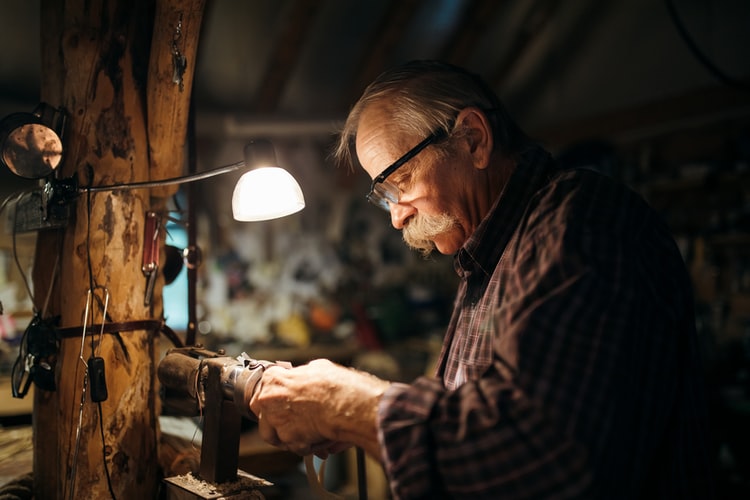

Jewellery trends are something that comes and go but the thing that remains constant is the love of people towards these never fades out. We have listed below nine major jewellery making techniques that a buyer must know in order to get an in-depth knowledge of the area and to keep in mind the pros and cons of every technique while purchasing jewellery made from them.
Mokume Gane is the type of jewellery making technique that takes into account wood-like patterns that are made with the help of hammer and chisel only. It finds its origin from Japan but today you can see this technique being followed in every country.
This technique involves creating layers of contrasting coloured metal alloys like copper, silver, and gold that are mixed together for beautiful designs and patterns. Now, after the layer is formed, the blocks that are created are flattened with the help of hammers and casted into various shapes.
JD Institute offers this jewellery design course to its students so that they get an intrinsic knowledge of this jewellery design.
Dichroic Glass jewellery making technique uses colourful methods to create beautiful and fascinating jewelleries. Though it is a very simple technique of making jewellery but the optical effect of it is worth talking about.
The glass that is used for making jewellery is coated with vaporised quartz, glass and metal oxides like titanium, aluminium, and magnesium accompanied by creating beautiful designs with the help of an electron beam gun. Thus, this method serves as one of the best methods to create intricate designs that look mesmerising.
Now, the mystery setting technique is the finest method of creating beautiful jewelleries. If you see yourself as the best jewellery designer, your motive should be to learn this technique by choosing jewellery design career from none other than the best fashion institute i.e. JD Institute.
In this technique, stones are coloured matched with stones that are of same colour and they are then fit perfectly into each other. All the stones are lined up against each other and then grooves of metal are created which helps in making the ornaments look beautiful and aesthetic.
This is another jewellery design that various jewellery design institutes such as JD institute offers to students. These jewelleries are better known during the reign of Queen Victoria. Though the technique and practice have long since waned in popularity, it is still possible to uncover human hair wreaths and jewellery in antique stores and attics.
This is one of the best jewellery making techniques that an aspiring jewellery student must look for and learn each and every aspect of it.
The portrait miniature technique is made with the help of miniatures that developed over centuries with the help of watercolour on vellum, which are then attached to the playing cards used by people. Further, you need to know that Italians and Germans were the ones who preferred oil paints on copper and thus copper became the metal to be used for creating this technique. The paint brushes that were used in this technique have hair attached to the feathers so that a beautiful finish can be seen on the jewellery.
JD Institute offers yet another type of jewellery design course that help students learn this beautiful jewellery making design i.e. Enameling. The origin of this technique can be found in 13Th century BC on the islands of Cyprus. Originally, metals that were used were Gold, Silver, Bronze, Iron that were coated with the porcelain enamel, but now you can use other types of metal too. These beautiful enamelling techniques produce an intrinsic design and patterns that can be seen on the jewellery are worth talking about.
Another type of jewellery making technique is the Venetian Glass jewellery.Venetian glass (Italian: vetro veneziano) has been produced on the Venetian island of Murano since the 13th century, and it is believed to have been made for over 1,500 years.
This type of jewellery making technique is also offered to the students of the JD Institute.
Now, since Jewellery design is something that requires hard work and commitment, you need to make sure that you learn each and every detail at par with those of professionals and for this the best place to study at JD Institute.
It’s usually made of gold or silver, with small beads or twisted threads, or both, soldered together or to the surface of an object made of the same metal, and arranged in artistic motifs. This jewellery design is a form of intricate metal work thus, looks very mesmerising and beautiful.
For this, you need to make sure that the jewellery is shaped properly without any disturbances or any lack of attention from your side.
Cameo is a method of carving an object such as an engraved gem, item of jewellery or vessel. It nearly always features a raised (positive) relief image; contrast with intaglio, which has a negative image. The kinds of designs that are created out of it are just mesmerising and elegant and are worth buying. This type of jewellery design is the best method of making jewelleries and takes into account intricate designs. JD institute takes into account all these jewellery designs and offers the same to the students.
So, you see that there are only nine main categories of jewellery designs that you must take into account if you are aspiring to become the best jewellery designer. Further, to make your choice clearer, JD Institute is the best platform to offer you all the listed jewellery designs techniques with full certainty. Thus, to have in-depth expertise and knowledge in the field of Jewellery design, your option should be to choose JD Institute as your first preference.